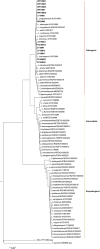Serological and molecular characteristics of pathogenic Leptospira in rodent populations in Fujian Province, China, 2018-2020
- PMID: 35672661
- PMCID: PMC9171958
- DOI: 10.1186/s12866-022-02566-2
Serological and molecular characteristics of pathogenic Leptospira in rodent populations in Fujian Province, China, 2018-2020
Abstract
Background: Leptospirosis is a significant emerging infectious disease worldwide. Rodents are considered to be the most critical hosts of Leptospira spp. Fujian Province is a region highly endemic for leptospirosis in China. However, the genetic diversity of leptospires circulating among rodents in Fujian is limited.
Results: The carrier status of rodents for Leptospira spp. was investigated by culture and serological detection in Fujian during 2018-2020. A total of 710 rodents, including 11 species, were trapped, with Rattus losea being the dominant trapped species (50.56%). Fourteen pathogenic Leptospira strains were obtained. Seven L. borgpetersenii serogroup Javanica strains belonging to ST143, 4 L. interrogans serogroup Icterohaemorrhagiae strains belonging to ST1 and ST17, 2 L. interrogans serogroup Bataviae strains belonging to ST96 and ST333, and 1 L. interrogans serogroup Pyrogenes strains belonging to ST332 were identified using 16S rDNA gene sequencing, microscopic agglutination test (MAT) and Multilocus sequence typing (MLST). L. borgpetersenii serogroup Javanica belonging to ST143 was the dominant type (50.00%). A total of 387 rodent serum samples were tested by MAT. Serum were considered positive for seroreactivity at a titer ≥ 1:160 against at least one serovar. A total of 90 (23.26%) serum samples tested positive, and four serogroups were identified, with Javanica being the dominant serogroup (87.78%), which was similar to the dominant serogroup isolated from rodents. This study demonstrates a high prevalence of leptospirosis in rodents and public health education among high-risk workers is highly recommended.
Conclusions: R. losea was the dominant trapped rodent, and L. borgpetersenii serogroup Javanica ST143 was widely distributed among rodents in Fujian from 2018 to 2020. Despite the low number of isolates obtained from rodents, this study suggests that continuous epidemiological surveillance of the aetiological characteristics of pathogenic Leptospira in wild animal reservoirs may help reduce the possible risk of disease transmission.
Keywords: Genetic diversity; Leptospira; Rodent; Serological characteristics.
© 2022. The Author(s).
Conflict of interest statement
The authors declare that they have no competing interests.
Figures


Similar articles
-
Genetic characteristics of pathogenic Leptospira in wild small animals and livestock in Jiangxi Province, China, 2002-2015.PLoS Negl Trop Dis. 2019 Jun 24;13(6):e0007513. doi: 10.1371/journal.pntd.0007513. eCollection 2019 Jun. PLoS Negl Trop Dis. 2019. PMID: 31233503 Free PMC article.
-
Determination of Leptospira borgpetersenii serovar Javanica and Leptospira interrogans serovar Bataviae as the persistent Leptospira serovars circulating in the urban rat populations in Peninsular Malaysia.Parasit Vectors. 2016 Mar 1;9:117. doi: 10.1186/s13071-016-1400-1. Parasit Vectors. 2016. PMID: 26927873 Free PMC article.
-
Molecular epidemiology of Leptospira spp. among wild mammals and a dog in Amami Oshima Island, Japan.PLoS One. 2021 Apr 22;16(4):e0249987. doi: 10.1371/journal.pone.0249987. eCollection 2021. PLoS One. 2021. PMID: 33886632 Free PMC article.
-
Leptospira infection in rats: A literature review of global prevalence and distribution.PLoS Negl Trop Dis. 2019 Aug 9;13(8):e0007499. doi: 10.1371/journal.pntd.0007499. eCollection 2019 Aug. PLoS Negl Trop Dis. 2019. PMID: 31398190 Free PMC article. Review.
-
Leptospira sp. infection in bats: A systematic review and meta-analysis.Transbound Emerg Dis. 2022 Sep;69(5):e2456-e2473. doi: 10.1111/tbed.14589. Epub 2022 May 30. Transbound Emerg Dis. 2022. PMID: 35533065
Cited by
-
Changing epidemiology of leptospirosis in China from 1955 to 2022.Infect Dis Poverty. 2025 Mar 3;14(1):17. doi: 10.1186/s40249-025-01284-x. Infect Dis Poverty. 2025. PMID: 40033390 Free PMC article.
-
First Molecular Detection of Pathogens Leptospira in Common Rodent Captured in North Algeria Urban Areas.Trop Med Infect Dis. 2022 Oct 29;7(11):335. doi: 10.3390/tropicalmed7110335. Trop Med Infect Dis. 2022. PMID: 36355878 Free PMC article.
-
Leptospira borgptersenii and Leptospira interrogans identified in wild mammals in Rio Grande do Sul, Brazil.Braz J Microbiol. 2024 Jun;55(2):1941-1948. doi: 10.1007/s42770-024-01348-4. Epub 2024 Apr 30. Braz J Microbiol. 2024. PMID: 38691328 Free PMC article.
-
Pathogenic Leptospira Infections in Hubei Province, Central China.Microorganisms. 2022 Dec 30;11(1):99. doi: 10.3390/microorganisms11010099. Microorganisms. 2022. PMID: 36677392 Free PMC article.
-
Zoonotic pathogens identified in rodents and shrews from four provinces, China, 2015-2022.Epidemiol Infect. 2023 Sep 7;151:e174. doi: 10.1017/S0950268823001450. Epidemiol Infect. 2023. PMID: 37675640 Free PMC article.
References
-
- Adler B. History of leptospirosis and leptospira. Curr Top Microbiol Immunol. 2015;387:1–9. - PubMed
Publication types
MeSH terms
LinkOut - more resources
Full Text Sources
Molecular Biology Databases
Miscellaneous

